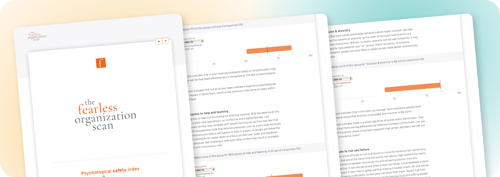Why Psychological Safety Matters
Imagine walking into a meeting where you have a bold idea. You pause…should you share it? What if it’s misunderstood? What if it fails? Now imagine you know that your team will listen with curiosity, offer support, and see possible failure as part of growth. That’s psychological safety in action, and it’s the difference between teams that survive and those that thrive.
Psychological safety is the foundation of high-performing teams. First introduced by Professor Amy C. Edmondson of Harvard Business School, it refers to a shared belief that it’s safe to take interpersonal risks. In psychologically safe environments, people speak up, ask for help, share ideas, admit mistakes, and challenge assumptions - without fear of embarrassment or punishment.
But how can you measure something that seems so intangible?
Introducing the Psychological Safety Index (PSI)
The Fearless Organization Scan makes the invisible visible. It offers a simple, research-backed way to measure psychological safety within teams. At the heart of the tool is the Psychological Safety Index (PSI), a snapshot of how psychological safety is experienced across your team or organization.
Based on Edmondson’s original research, the PSI uses a short, anonymous survey to assess psychological safety across four specific domains. With a high degree of internal consistency (Cronbach’s Alpha of .82 to .86), this instrument has been validated globally and used in a wide range of industries.
The result? A powerful data set that gives teams a clear, credible, and actionable view of their culture.
The Four Domains of Psychological Safety
Psychological safety is a measure of team dynamic that encompasses different interpersonal communication aspects. The PSI breaks an overal score of psychological safety down into four key domains, each revealing a different facets of the interpersonal dynamics:
-
Attitude to Risk & Failure
Is it safe to try something new? How does the team respond to mistakes, experimentation, and failure? -
Open Conversation
Can people speak honestly and directly, even when what needs to be said is uncomfortable or challenges authority? -
Inclusion & Diversity
Do all team members include on another regardless of their background, identity, or point of view? -
Willingness to Help
Are team members proactive in supporting one another by making it easy to ask for help? Are you appreciated for the contribution you're making to a team?
How the Survey Works
The Fearless Organization Scan is simple and lightweight. Each participant receives a short online survey with statements aligned to the four domains. Responses are anonymous and aggregated, allowing for team-insights or organization-wide insights.
Once the data is collected, you receive a visual report that shows average scores in each domain, identifies trends, and compares results to global benchmarks. It’s not just a report card, it’s a springboard for meaningful dialogue.

From Scores to Stories: Facilitating Transformational Conversations
The real magic of the PSI isn’t in the numbers, it’s in the conversations those numbers inspire.
Rather than making assumptions based on averages, the PSI encourages teams to ask:
-
What’s behind these scores?
-
What stories do we tell ourselves, and each other, about how things work here?
-
What’s helping us, and what’s holding us back?
For example:
-
A low score in Attitude to Risk & Failure could reflect a culture where mistakes are met with blame, stifling innovation and initiative.
-
A dip in Willingness to Help might reveal overwork, unclear roles, or hidden silos.
These insights can lead to honest, empathetic, and constructive team conversations - the kind that foster real change.
Why Leaders and Teams Use the PSI
Organizations use the Fearless Organization Scan for many reasons:
-
To assess culture before or after a major transformation
-
To improve innovation, engagement, or cross-functional collaboration
-
To measure the impact of leadership development programs
-
To support change initiatives with data and dialogue
-
To track improvements in team health over time
But whatever the reason, the outcome is the same: teams learn to talk about what matters most, and to do something about it.




